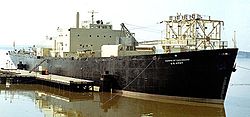Sturgis (ship)
|
||||||||||||||||
|
||||||||||||||||
|
||||||||||||||||
|
||||||||||||||||
The Sturgis or MH-1A was the world's first nuclear-powered power station ship . It was converted from a Liberty freighter built in 1945 from 1963 to 1967 .
history
In the 1950s, as part of the Army Nuclear Power Program , the United States Army Corps of Engineers investigated the construction of floating nuclear power plants to supply power to military facilities in remote locations.
The Liberty ship intended for conversion was a unit of the American standard type Z-EC2-S-C5. The ship, built in 1945 as the Charles H. Cugle freighter at the JA Jones Construction shipyard in Panama City, Florida, was one of more than 2,700 units of this design by the United States Maritime Commission . The ship was assigned to the reserve fleet after the end of the war .
The conversion to a power station ship was commissioned from the Alabama Dry Dock and Shipbuilding Corporation in Mobile from 1963 to 1967 . The old middle section of the ship was removed, the propulsion system expanded and a new middle section with the approximately 17 million US dollars expensive reactor MH-1A supplied by Martin Marietta was installed (the abbreviation meant: M = Mobile, H = High-Powered, 1A = first unit built). After the work was completed, the Sturgis was initially deployed in Fort Belvoir, Virginia, from 1967 and towed to Gatunsee in the Panama Canal one year later , where it supplied the Panama Canal zone with energy in the following years and was used in parallel as a water desalination plant. The high operating costs and budget cuts by the US Army led to the reactor being shut down when the fuel rods were to be replaced in 1976. The ship was then decontaminated at Fort Eustis before being laid up in the James River Reserve Fleet in 1978.
Since July 2014, the ship has been prepared for demolition by the Chicago Bridge & Iron Company at the Malin International Shipyard. After the completion of the approximately 35 million US dollar expensive disposal of the radiation-contaminated part of the Sturgis , the ship was towed to the scrapping yard in Brownsville, Texas, for final scrapping and demolished there.
literature
- Nuclear Power: The marine industry is ready and capable to proceed . In: Marine Engineering / Log , No. 3, Vol. LXIV, March 1966, pp. 48-51, 59
- Hans B. Honerlah, Brian P. Hearty: Characterization of the Nuclear Barge Sturgis , WM'02 Conference, February 2002, Tucson
Web links
Individual evidence
- ↑ Floating Nuclear Plant Sturgis Dismantled. The Maritime Executive, LLC, March 16, 2019, accessed April 25, 2019 .
